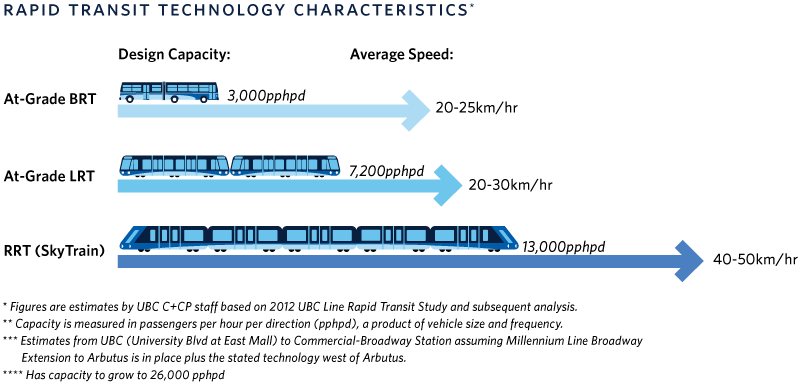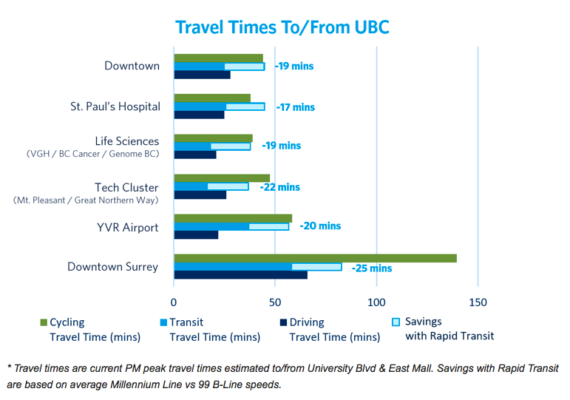Why SkyTrain Technology?

SkyTrain to UBC is the best solution
TransLink and the Province of BC explored several options for serving the Broadway corridor between UBC and Commercial Drive in the UBC Line Rapid Transit Study (2009-2012). They compared the costs and benefits of Bus Rapid Transit (BRT), Light Rail Transit (LRT) and Rail Rapid Transit (RRT or SkyTrain) options.
RRT-SkyTrain scored the highest on every front: travel time savings, mode share change, economic growth, community benefits and GHG reductions.

SkyTrain provides the fastest, most-reliable travel times with the fewest transfers
In almost every case, SkyTrain to UBC will reduce transit times below those of a car during PM peak travel times. These time savings will improve life for commuters and help get more cars off the road, further reducing congestion and GHGs.

SkyTrain has the greatest capacity to meet long term needs
SkyTrain is the only technology with room to meet future demand along the corridor beyond about 2045, especially if the region is successful in achieving the TransLink target of 50% of all trips by sustainable modes by that same time. It’s anticipated that by 2045 there will be just under 119,000 daily boardings on SkyTrain between Arbutus and UBC.
SkyTrain is the most cost-effective alternative
SkyTrain is the most cost-effective transit option. It attracts more riders and saves people more time. As an automated system with high capacity vehicles, cost per rider is lower than smaller BRT and LRT vehicles with drivers.
SkyTrain does not impact traffic flow
Running underground or on an elevated guideway, SkyTrain does not interfere with traffic. At-grade alternatives create ongoing impacts, including turning and pedestrian crossing restrictions.
SkyTrain attracts the highest number of users
Faster, more reliable and better integrated with the broader network, SkyTrain attracts more riders. This maximizes benefits and will help achieve mode share, environmental and economic targets.
LRT is not cost-effective in the long term
Despite its lower initial capital costs, LRT is not a viable option along the busy Broadway corridor for a number of reasons:
- Travel time savings would be minimal relative to B-Line buses since LRT vehicles still interact with traffic at intersections, reducing their speed, and passengers would still need to transfer to access the rest of the SkyTrain network.
- LRT vehicles would be at capacity about a decade after opening without the ability to expand. LRT is not a long-term solution.
- Since LRT uses part of the road right-of-way, it would contribute to traffic congestion and increase auto travel times, negating some of its benefits.
- The need for additional property acquisition and construction of an LRT Operations and Maintenance Facility reduces the potential cost savings of LRT relative to SkyTrain.
Compared to SkyTrain, LRT from Arbutus to UBC would be roughly two thirds of the cost, but deliver only about a quarter of the capacity and attract less than a third of the ridership in 2045.